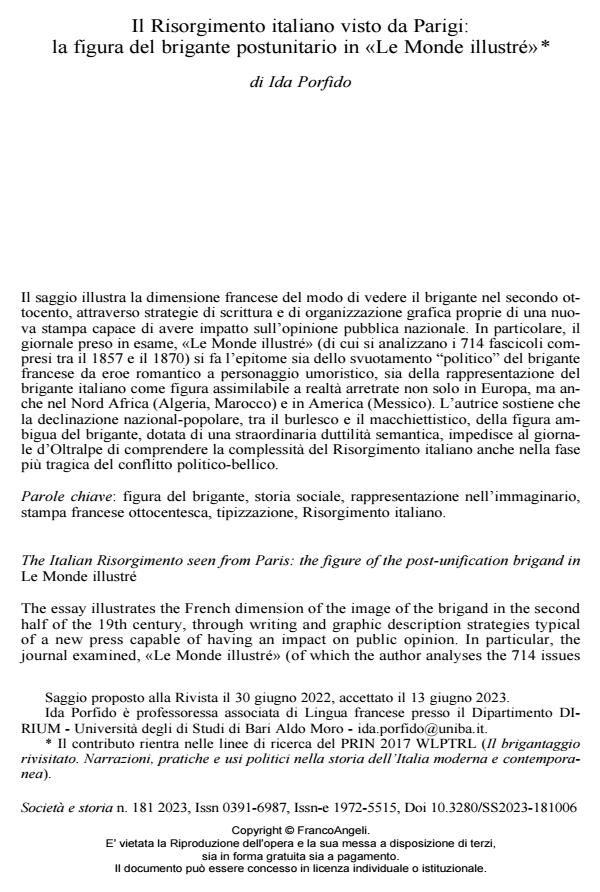The Italian Risorgimento seen from Paris: the figure of the post-unification brigand in Le Monde illustré
Journal title SOCIETÀ E STORIA
Author/s Ida Porfido
Publishing Year 2023 Issue 2023/181
Language Italian Pages 29 P. 503-531 File size 938 KB
DOI 10.3280/SS2023-181006
DOI is like a bar code for intellectual property: to have more infomation
click here
Below, you can see the article first page
If you want to buy this article in PDF format, you can do it, following the instructions to buy download credits

FrancoAngeli is member of Publishers International Linking Association, Inc (PILA), a not-for-profit association which run the CrossRef service enabling links to and from online scholarly content.
The essay illustrates the French dimension of the image of the brigand in the second half of the 19th century, through writing and graphic description strategies typical of a new press capable of having an impact on public opinion. In particular, the journal examined, «Le Monde illustré» (of which the author analyses the 714 issues between 1857 and 1870) is the epitome of both the ‘political’ demotion of the Fren- ch brigand from romantic hero to humorous character, and of the representation of the Italian brigand as a figure reminiscent to backward realities not only in Europe, but also in North Africa (Algeria, Morocco) and America (Mexico). The author argues that the national-popular declination, between the grotesque and the macchiet- tistico, of the ambiguous figure of the brigand, endowed with an extraordinary semantic ductility, prevents the transalpine newspaper from understanding the complexity of the Italian Risorgimento even in the most tragic phase of the political-war conflict.
Keywords: figure of the brigand, social history, representation in the imagination, 19th century French press, typification, Italian Risorgimento.
- Amossy A. e Herschberg P. (2015), Stéréotypes et clichés, Paris, Armand Colin. Bacot J.-P. (2005), La Presse illustrée au XIXème siècle, une histoire oubliée, Limoges, Presses Universitaires de Limoges.
- Chartier R. (1981), L’ancien régime typographique: réflexions sur quelques travaux récents [note critique], in «Annales», 36, 2, pp. 191-209.
- Jossa S. (2013), Un paese senza eroi. L’Italia da Jacopo Ortis a Montalbano, Roma- Bari, Laterza.
- Kalifa D., Régnier P., Thérenty M.-E. e Vaillant A. (a cura di) (2011), La civilisation du journal. Histoire culturelle et littéraire de la presse française au XIXème siècle, Paris, Nouveau monde. «Le Monde illustré» (1857-1870).
- Lupo S. (2011), L’unificazione italiana. Mezzogiorno, rivoluzione, guerra civile, Roma, Donzelli.
- Mascilli Migliorini L. (2003), Il mito dell’eroe, Napoli, Guida.
- Nigro R. (2006), Giustiziateli sul campo. Letteratura e banditismo da Robin Hood ai giorni nostri, Milano, Rizzoli.
- Pinto C. (2019), La guerra per il Mezzogiorno. Italiani, borbonici e briganti 1860- 1870, Roma-Bari, Laterza.
- Rancière J. (2000), Le Partage du sensible. Esthétique et politique, Paris, La Fabrique éditions.
- Schneider H. (1992), «Fra Diavolo», in The New Grove Dictionary of Opera, a cura di S. Sadie, London, Macmillan Reference.
- Tatasciore G. (2015), Rappresentare il crimine. Strategie politiche e immaginario let- terario nella repressione del brigantaggio (1860-70), in «Meridiana», 84, pp. 237- 258.
- Tatasciore G. (2017), La fabbrica del criminale. Alexandre Dumas e la rappresentazione del brigantaggio meridionale tra letteratura e politica, in «Società e storia», 156, pp. 269-303.
- Tatasciore G. (2019), L’invenzione di un’icona borbonica: il brigante come patriota napoletano?, in «Meridiana», 95, pp. 169-194.
- Toscano A. (2009), Critique amoureuse des Français, Paris, Hachette.
- Watelet J. (1998), La Presse illustrée en France, 1814-1914, Villeneuve-d’Ascq, Ate- lier National de Reproduction des Thèses.
Ida Porfido, Il Risorgimento italiano visto da Parigi: la figura del brigante postunitario in «Le Monde illustré» in "SOCIETÀ E STORIA " 181/2023, pp 503-531, DOI: 10.3280/SS2023-181006